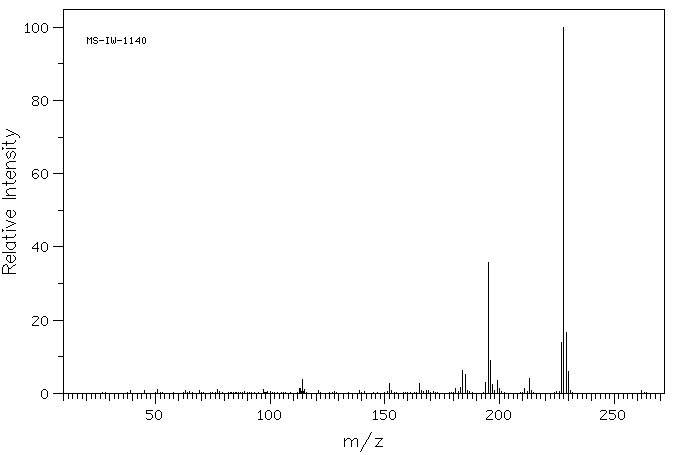2,8-dimethylphenoxathiin | 21797-73-9
中文名称
——
中文别名
——
英文名称
2,8-dimethylphenoxathiin
英文别名
2,8-dimethyl-phenoxathiine;2,8-dimethylphenoxathiine
CAS
21797-73-9
化学式
C14H12OS
mdl
——
分子量
228.315
InChiKey
FNLBYUMDLZWDPC-UHFFFAOYSA-N
BEILSTEIN
——
EINECS
——
-
物化性质
-
计算性质
-
ADMET
-
安全信息
-
SDS
-
制备方法与用途
-
上下游信息
-
文献信息
-
表征谱图
-
同类化合物
-
相关功能分类
-
相关结构分类
计算性质
-
辛醇/水分配系数(LogP):5.3
-
重原子数:16
-
可旋转键数:0
-
环数:3.0
-
sp3杂化的碳原子比例:0.14
-
拓扑面积:34.5
-
氢给体数:0
-
氢受体数:2
安全信息
-
海关编码:2934999090
SDS
上下游信息
-
下游产品
中文名称 英文名称 CAS号 化学式 分子量 —— 2,8-di(2-aminoethyl)phenoxathiin 860818-30-0 C16H18N2OS 286.398 —— 2,8-di(N-formylaminoethyl)phenoxathiin 860818-32-2 C18H18N2O3S 342.419 —— 2,8-dimethylphenoxathiin 10-oxide 215038-08-7 C14H12O2S 244.314 —— 2,8-dimethylphenoxathiin-10,10-dioxide 21797-74-0 C14H12O3S 260.313 —— 2,8-diformylphenoxathiin-10,10-dioxide 860818-27-5 C14H8O5S 288.281 —— 2,8-di(bromomethyl)phenoxathiin-10,10-dioxide 860818-25-3 C14H10Br2O3S 418.106 —— 10-oxo-10λ4-phenoxathiine-2,8-dicarboxylic acid 52054-64-5 C14H8O6S 304.28 —— 2,8-di(dibromomethyl)phenoxathiin-10,10-dioxide 860818-24-2 C14H8Br4O3S 575.898 —— 2,8-di(cyanomethyl)phenoxathiin-10,10-dioxide 860818-29-7 C16H10N2O3S 310.333 —— Phenoxathiin, 1,3,7,9-tetrachloro-2,8-dimethyl- 103412-83-5 C14H8Cl4OS 366.1 —— 2,8-di(2-nitroethenyl)phenoxathiin-10,10-dioxide 860818-28-6 C16H10N2O7S 374.331 —— 10,10-dioxo-10λ6-phenoxathiine-2,8-dicarboxylic acid 4667-24-7 C14H8O7S 320.279 —— 10,10-dioxo-10λ6-phenoxathiine-2,8-dicarboxylic acid dimethyl ester 4779-57-1 C16H12O7S 348.333 —— 2,8-dimethyl-4,6-bis(aminomethyl)-phenoxathiin-10,10-dioxide 154459-10-6 C16H18N2O3S 318.397 - 1
- 2
反应信息
-
作为反应物:描述:2,8-dimethylphenoxathiin 在 N-溴代丁二酰亚胺(NBS) 、 双氧水 、 间氯过氧苯甲酸 作用下, 以 四氯化碳 、 水 、 溶剂黄146 为溶剂, 反应 70.0h, 生成 2,8-di(bromomethyl)phenoxathiin-10,10-dioxide参考文献:名称:实际合成大环双苄基异喹啉的步骤摘要:有超过400种双苄基异喹啉生物碱报道,其中许多具有令人感兴趣的生物活性,但已报道的合成长而低产。结果,没有系统地尝试开发潜在的治疗应用。硫“缝合”的概念限制了合成中中间体的构象自由,将有可能允许使用相对有效的途径制备天然产物的类似物。据报道,基于2,8-二甲基苯恶那啶的中间体硫杂环的合成通过2,8-双(溴甲基)苯恶ath啶-10,10-二氧化物导致合成3,4,8,9-四氢-13- oxa-6-thia-2,10-二氮杂戊并五烯,是通往各种大环双苄基异喹啉的关键潜在中间体。DOI:10.1002/jhet.5570420426
-
作为产物:参考文献:名称:实际合成大环双苄基异喹啉的步骤摘要:有超过400种双苄基异喹啉生物碱报道,其中许多具有令人感兴趣的生物活性,但已报道的合成长而低产。结果,没有系统地尝试开发潜在的治疗应用。硫“缝合”的概念限制了合成中中间体的构象自由,将有可能允许使用相对有效的途径制备天然产物的类似物。据报道,基于2,8-二甲基苯恶那啶的中间体硫杂环的合成通过2,8-双(溴甲基)苯恶ath啶-10,10-二氧化物导致合成3,4,8,9-四氢-13- oxa-6-thia-2,10-二氮杂戊并五烯,是通往各种大环双苄基异喹啉的关键潜在中间体。DOI:10.1002/jhet.5570420426
文献信息
-
Sterically Demanding Diphosphonite Ligands–Synthesis and Application in Nickel-Catalyzed Isomerization of 2-Methyl-3-Butenenitrile作者:Jarl Ivar van der Vlugt、Alison C. Hewat、Samuel Neto、Rafael Sablong、Allison M. Mills、Martin Lutz、Anthony L. Spek、Christian Müller、Dieter VogtDOI:10.1002/adsc.200303240日期:2004.7of these diphosphonite ligands towards Ni(II) and Ni(0) precursors is investigated, both by NMR spectroscopy as well as X-ray crystallography and compared with the behaviour of diphosphine ligands such as Xantphos. The molecular structure for complex 9, trans-[NiBr2(1)] is described in detail. The nickel-catalyzed isomerization of 2-methyl-3-butenenitrile to 3-pentenenitrile is studied, a relevant一类新的空间要求的二亚膦酸酯的合成1 - 8,根据刚性骨架,进行说明。起始原料都是可商购的,并且该方法允许采用模块化方法。所有配体已被充分表征,包括X射线晶体结构为化合物1,4,5-双二[(2-叔丁基)苯基] phosphonito} -9,9-二甲基呫。通过NMR光谱以及X射线晶体学研究了这些二膦酸酯配体对Ni(II)和Ni(0)前体的配位,并与二膦配体(如Xantphos)的行为进行了比较。配合物9的分子结构,反式-[NiBr 2((1)]被详细描述。研究了2-甲基-3-丁烯腈在镍催化下异构化为3-戊烯腈的方法,这是丁二烯在工业上重要的氢氰化的重要步骤(杜邦己二腈工艺)。在这种可逆的CC键活化反应中,获得了对所需的3-戊烯腈的良好活性和选择性。
-
<i>N-</i> Benzyldithiocarbamate Salts as Sulfur Sources to Access Tricyclic Thioheterocycles Mediated by Copper Species作者:Bingling Luo、Qingbin Cui、Hongwen Luo、Yumin Hu、Peng Huang、Shijun WenDOI:10.1002/adsc.201600405日期:2016.9.1Using an easily prepared triethylammonium N‐benzyldithiocarbamate salt as a sulfur source, a dual C−S functionalization of cyclic diaryliodoniums to form tricyclic thioheterocycles is realized. Our method uses the readily available copper sulfate to accelerate the chemical transformation under mild conditions. A broad range of cyclic diaryliodoniums with a ring size from 5‐ to 7‐membered can be employed
-
Electronic effects in the nickel-catalysed hydrocyanation of styrene applying chelating phosphorus ligands with large bite angles ‡作者:Wolfgang Goertz、Wilhelm Keim、Dieter Vogt、Ulli Englert、Maarten D. K. Boele、Lars A. van der Veen、Paul C. J. Kamer、Piet W. N. M. van LeeuwenDOI:10.1039/a802269k日期:——Chelating phosphorus ligands with a rigid backbone and a large natural bite angle were applied in the nickel-catalysed hydrocyanation of styrene. The para substituents in the diphenylphosphanyl moiety of the 4,6-bis(diphenylphosphanyl)-2,8-dimethylphenoxathiine (Thixantphos) ligands were varied and their electronic effects on the activity and selectivity of the catalytic experiments were investigated. The activity of the nickel complexes decreased when electron-donating substituents lead to a more basic phosphorus while electron-withdrawing substituents led to a higher activity. The results of variable temperature 31P-1H} NMR experiments on the in situ catalysts are discussed in relationship to the catalytic performance. 4,6-Bis(diphenylphosphanyl)-2,8-dimethylphenoxathiine (Thixantphos) L1d and the complexes [NiCl2L1d] 1 and [Ni(CN)2L1a] 2 (p-Me2N on phenyl) have been characterised by single-crystal X-ray diffraction. Complex 2 represents the first crystal structure of a monomeric dicyanonickel(II) complex with a PâP chelating ligand. The geometries of ligand L1d and complex 1 were predicted by molecular mechanics calculations.采用刚性主链和大自然咬合角的螯合磷配体,在镍催化的苯乙烯氢氰化反应中应用。研究了4,6-双(二苯基膦)-2,8-二甲基苯氧噻啉(Thixantphos)配体中二苯基膦基团的对位取代基的变化及其对催化实验活性和选择性的电子效应。当电子给体取代基使磷的碱性增强时,镍配合物的活性下降;而电子吸收取代基则导致活性提高。讨论了在原位催化剂上进行的可变温度31P-1H} NMR实验的结果与催化性能之间的关系。4,6-双(二苯基膦)-2,8-二甲基苯氧噻啉(Thixantphos)L1d及其配合物[NiCl2L1d] 1和[Ni(CN)2L1a] 2(苯基上的p-Me2N)通过单晶X射线衍射进行了表征。配合物2代表了第一个具有P–P螯合配体的单体二氰镍(II)配合物的晶体结构。通过分子力学计算预测了配体L1d和配合物1的几何构型。
-
Electronic Effect on Rhodium Diphosphine Catalyzed Hydroformylation: The Bite Angle Effect Reconsidered作者:Lars A. van der Veen、Maarten D. K. Boele、Frank R. Bregman、Paul C. J. Kamer、Piet W. N. M. van Leeuwen、Kees Goubitz、Jan Fraanje、Henk Schenk、Carles BoDOI:10.1021/ja981969e日期:1998.11.1The electronic effect in the rhodium diphosphine catalyzed hydroformylation was investigated. A series of electronically modified thixantphos ligands was synthesized, and their effects on coordination chemistry and catalytic performance were studied. Phosphine basicity was varied by using p-(CH3)2N, p-CH3O, p-H, p-F, p-Cl, or p-CF3 substituents on the diphenylphosphine moieties. X-ray crystal structure研究了铑二膦催化的加氢甲酰化中的电子效应。合成了一系列电子修饰的thixantphos配体,并研究了它们对配位化学和催化性能的影响。通过在二苯基膦部分上使用 p-(CH3)2N、p- O、pH、pF、p-Cl 或 p-CF3 取代基来改变膦的碱度。获得配合物(thixantphos)Rh(CO)H(PPh3)和(p- O-thixantphos)Rh(CO)H(PPh3)的X射线晶体结构测定。(二膦)Rh(CO)H(PPh3)和(二膦)Rh(CO)2H配合物的溶液结构通过红外光谱和核磁共振光谱进行了研究。IR 和 1H NMR 光谱表明 (diphosphine)Rh(CO)2H 配合物由双赤道 (ee) 和赤道顶 (ea) 异构体的动态平衡组成。证明平衡组成取决于膦碱度;ee:ea 异构体比例逐渐从 p-( )2N-取代配体的几乎 1 变为 p- -subs 的超过 9.
-
Verfahren zur Hydrodechlorierung von kernchlorierten ortho-Xylolen申请人:Clariant GmbH公开号:EP1398305A1公开(公告)日:2004-03-17Verfahren zur Hydrodechlorierung von kernchlorierten o-Xylolen und Rückgewinnung von o-Xylol unter Bildung von Chlorwasserstoff wobei die kernchlorierten o-Xylole in der Gasphase an einem Edelmetall enthaltenden Katalysator bei einer Temperatur im Bereich von 220 bis 360°C hydriert werden. Der Katalysator enthält vorzugsweise Palladium oder Platin, insbesondere geträgertes Palladium oder Platin. Die kernchlorierten o-Xylole können einzeln oder als Gemische eingesetzt werden.
表征谱图
-
氢谱1HNMR
-
质谱MS
-
碳谱13CNMR
-
红外IR
-
拉曼Raman
-
峰位数据
-
峰位匹配
-
表征信息
同类化合物
高氟奋乃静
马来酸甲哌丙嗪
马来酸奋乃静
马来酸乙巯拉嗪
锁匹达新
醋酸奋乃静
醋异丙嗪
酒石酸异丁嗪
还原亚甲蓝
达赛马嗪
螺氯丙嗪
莫雷西嗪亚砜
茶氯酸异丙嗪
苹果酸硫乙拉嗪
苯达莫司汀杂质A
苯甲酸2-(2H-1,4-苯并噻嗪-3-基)酰肼
苯甲酸,4-硝基-2-[[3-(三氟甲基)苯基]氨基]-
苯甲酰基氧基甲基-[3-(2-氯吩噻嗪-10-基)丙基]-二甲基氯化铵
苯并噻嗪-5-氧化
苯并噻嗪-5-正离子,3,7-二(二甲氨基)-4-碘-,氯化
苯并噻嗪,10-(2-(4-丙基-1-哌嗪基)丙基)-
苯并[b]吩噻嗪-12-基(苯基)甲酮
苯并[a]吩噻嗪-5-酮
苯丙嗪
苄酰基无色亚甲基兰
芬诺宁
芬乙嗪
舒多昔康
羟乙哌氟嗪
美索哒嗪
美索丙嗪
美洛昔康钾盐
美洛昔康钠
美洛昔康-d3
美洛昔康
美托奋乃酯
美托哌丙嗪酸
美托哌丙嗪
美托咪嗪-d6
美喹他嗪亚砜
美喹他嗪
磺达嗪
硫堇(劳氏紫)
硫利达嗪杂质A(EP)
硫利达嗪N-氧化物
硫利达嗪-5-亚砜
硫利达嗪
硫代哒嗪-d35-亚砜
硫丙拉嗪
盐酸诺美丙嗪








